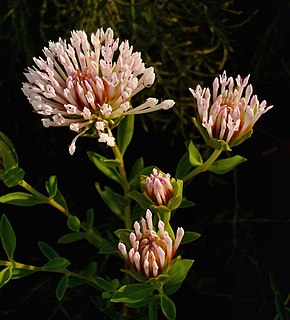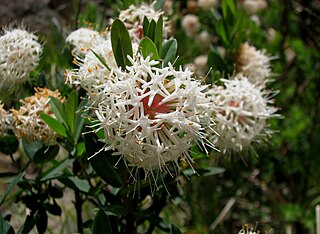
Pimelea linifolia, commonly known as slender rice flower is a common, variable shrub widespread throughout eastern Australia. It has narrow leaves arranged in opposite pairs, and usually white flowers arranged in heads of seven or more on the ends of the stems, with four lance-shaped bracts at the base of the inflorescence. The plant may be toxic to livestock.
Pimelea microcephala is a dioecious shrub in the family Thymelaeaceae, native to Australia. It grows up to 4 metres high and produces greenish-yellow flowerheads. The male flowerheads have 13 to 100 flowers while the female flowerheads have 7 to 12. The leaves are 7 to 40 mm long and 1 to 4 mm wide.

Pimelea humilis, also known as common riceflower or dwarf riceflower, is a shrub in the family Thymelaeaceae, native to Australia. It grows up to 0.5 metres in height. Flowerheads have 12 to 52 whitish flowers that are either female or bisexual. The leaves are 5 to 15 mm long and 2 to 8 mm wide.

Pimelea flava is a shrub in the family Thymelaeaceae which is endemic to Australia.

Pimelea octophylla, commonly known as woolly riceflower or downy riceflower, is a shrub in the family Thymelaeaceae. The speciesis native to south-eastern Australia. It grows up to 1 metre high and produces cream to pale yellow terminal flowerheads with long white hairs. The flowerheads have 25 to 150 flowers. The leaves are 2 to 15 mm long and 0.5 to 5 mm wide.

Pimelea alpina, the alpine rice-flower, is a small shrub species in the family Thymelaeaceae. It is endemic to Southern Australia.

Pimelea spectabilis, or Bunjong, is a species of shrub in the family Thymelaeaceae, endemic to Western Australia. It is erect in habit, growing to between 0.5 and 2 metres high. The pink and white flowers are produced between August and December in its native range.

Pimelea calcicola is a species of shrub in the family Thymelaeaceae, endemic to Western Australia. It is erect or spreading in habit, growing to between 0.2 and 1 metre high. Pink flowers are produced between September and November in its native range.

Pimelea ferruginea is a small shrub native to southwest Western Australia. It was described by Labillardiere in 1805.

Pimelea hewardiana, also known as forked riceflower, is a shrub in the family Thymelaeaceae. The species is native to western Victoria and south-eastern South Australia. Plants are between 40 and 70 cm high and have leaves that are glabrous, narrow-elliptic and about 12mm long and 3mm wide. They have blunt tips and arranged in opposite pairs. Small, yellow tubular flowers appear between April and October in the species' native range.
Pimelea serpyllifolia, commonly known as the thyme riceflower, is a species of plant in the family Thymelaeaceae that is endemic to southern Australia. It is a small dioecious shrub that grows to 1.5 m in height where sheltered, though it has a prostrate or stunted habit in exposed positions. The stems are glabrous and the leaves small and blue-green. It bears clusters of tiny yellow flowers.

Pimelea ligustrina, commonly known as tall rice-flower, is a shrub species in the family Thymelaeaceae. It is endemic to south-eastern Australia.

Pimelea suaveolens, commonly known as the scented banjine or silky-yellow banjine is a slender shrub with large, rather hairy yellow inflorescences. It ranges in forest areas of the south-west of Western Australia from New Norcia to Albany.
Pimelea imbricata is a small shrub species in the family Thymelaeaceae. It is native to Western Australia.
Pimelea longiflora is a species of small shrub in the family Thymelaeaceae. It is native to Western Australia.
Pimelea nivea is a species of small shrub, of the family Thymelaeaceae. It is native to Australia, where it is endemic to Tasmania.
Pimelea pauciflora is a species of shrub in the family Thymelaeaceae. It is native to Eastern Australia.
Pimelea sericea is a species of shrub in the family Thymelaeaceae. It is native to Australia, specifically Tasmania.
Pimelea traversii is a species of shrub in the family Thymelaeaceae. It is native to New Zealand. The specific epithet traversii is in honor of naturalist Henry H. Travers (1844-1928), son of William Thomas Locke Travers.
Pimelea neo-anglica is a species of shrub in the family Thymelaeaceae. It is native to Australia, specifically Queensland.












